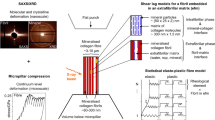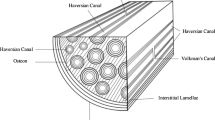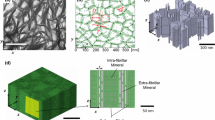Abstract
Bone is a biomaterial with a structural load-bearing function. Investigating the biomechanics of bone at the nanoscale is important in application to tissue engineering, the development of bioinspired materials, and for characterizing factors such as age, trauma, or disease. At the nanoscale, bone is composed of fibrils that are primarily a composite of collagen, apatite crystals (mineral), and water. Though several studies have been done characterizing the mechanics of fibrils, the effects of variation and distribution of water and mineral content in fibril gap and overlap regions are unexplored. We investigate how the deformation mechanisms of collagen fibrils change as a function of mineral and water content. We use molecular dynamics to study the mechanics of collagen fibrils of 0 wt%, 20 wt%, and 40 wt% mineralization and 0 wt%, 2 wt%, and 4 wt% hydration under applied tensile stresses. We observe that the stress–strain behavior becomes more nonlinear with an increase in hydration, and an increase in mineral content for hydrated fibrils under tensile stress reduces the nonlinear stress versus strain behavior caused by hydration. The Young’s modulus of both non-mineralized and mineralized fibrils decreases as the water content increases. As the water content increases, the gap/overlap ratio increases by approximately 40% for the non-mineralized cases and 16% for the highly mineralized cases. Our results indicate that variations in mineral and water content change the distribution of water in collagen fibrils and that the water distribution changes the deformation of gap and overlap regions under tensile loading.







Similar content being viewed by others
References
Ahsan AS (2017) Effect of intrafibrillar mineralization on the mechanical properties of osteogenesisimperfecta bone using a cohesive finite element approach. The University of Texas, SanAntonio
Andriotis OG, Desissaire S, Thurner PJ (2018) Collagen Fibrils: Nature’s Highly Tunable Nonlinear Springs. ACS nano 12:3671–3680
Bala Y, Seeman E (2015) Bone's Material Constituents and their Contribution to Bone Strength in Health, Disease, and Treatment. Calcif Tissue Int 97:308–326
Beniash E (2011) Biominerals-hierarchical nanocomposites: the example of bone. Wires Nanomed Nanobiotechnol 3:47–69
Bevington P, Robinson DK (2003) Data reduction and error analysis for the physical sciences. McGraw-Hill Education
Bland JM, Altman DG (1986) Statistical methods for assessing agreement between two methods of clinical measurement. Lancet 1:307–310
Bonar LC, Lees S, Mook HA (1985) Neutron-Diffraction Studies of Collagen in Fully Mineralized Bone. J Mol Biol 181:265–270
Currey JD (2002) Bones: structure and mechanics. Princeton University Press, Princeton
Depalle B, Qin Z, Shefelbine SJ, Buehler MJ (2016) Large deformation mechanisms, plasticity, and failure of an individual collagen fibril with different mineral content. J Bone Miner Res 31:380–390
Dorozhkin SV, Epple M (2002) Biological and medical significance of calcium phosphates. Angew Chem Int Ed 41:3130–3146
Dubey DK, Tomar V (2013) Ab initio investigation of strain dependent atomistic interactions at two tropocollagen-hydroxyapatite interfaces. J Eng Mater Technol 135:021015
Eppell S, Smith B, Kahn H, Ballarini R (2006) Nano measurements with micro-devices: mechanical properties of hydrated collagen fibrils. J R Soc Interface 3:117–121
Fantner GE, Adams J, Turner P, Thurner PJ, Fisher LW, Hansma PK (2007) Nanoscale ion mediated networks in bone: osteopontin can repeatedly dissipate large amounts of energy. Nano Lett 7:2491–2498
Fratzl P (ed) (2008) Collagen: structure and mechanics, an introduction. In: Collagen. Springer, Boston, pp 1–13
Gao H, Ji B, Jäger IL, Arzt E, Fratzl P (2003) Materials become insensitive to flaws at nanoscale: lessons from nature. Proc Natl Acad Sci 100:5597–5600
Gautieri A, Vesentini S, Redaelli A, Buehler MJ (2011) Hierarchical structure and nanomechanics of collagen microfibrils from the atomistic scale up. Nano Lett 11:757–766
Gul-E-Noor F, Singh C, Papaioannou A, Sinha N, Boutis GS (2015) Behavior of water in collagen and hydroxyapatite sites of cortical bone: fracture, mechanical wear, and load bearing studies. J Phys Chem C 119:21528–21537
Gupta HS, Seto J, Wagermaier W, Zaslansky P, Boesecke P, Fratzl P (2006) Cooperative deformation of mineral and collagen in bone at the nanoscale. P Natl Acad Sci USA 103:17741–17746
Hamed E, Lee Y, Jasiuk I (2010) Multiscale modeling of elastic properties of cortical bone. Acta Mech 213:131–154
Hang F, Barber AH (2011) Nano-mechanical properties of individual mineralized collagen fibrils from bone tissue. J R Soc Interface 8:500–505
Humphrey W, Dalke A, Schulten K (1996) VMD: visual molecular dynamics. J Mol Graph 14:33–38
Jäger I, Fratzl P (2000) Mineralized collagen fibrils: a mechanical model with a staggered arrangement of mineral particles. Biophys J 79:1737–1746
Kinney JH, Pople JA, Driessen CKH, Breunig TM, Marshall GW, Marshall SJ (2001) Intrafibrillar mineral may be absent in dentinogenesis imperfecta type II (DI-II). J Dent Res 80:1555–1559
Lees S, Prostak KS, Ingle VK, Kjoller K (1994) The loci of mineral in turkey leg tendon as seen by atomic-force microscope and electron-microscopy. Calcif Tissue Int 55:180–189
Lin L, Samuel J, Zeng X, Wang X (2017) Contribution of extrafibrillar matrix to the mechanical behavior of bone using a novel cohesive finite element model. J Mech Behav Biomed 65:224–235
Liu Y, Thomopoulos S, Chen C, Birman V, Buehler MJ, Genin GM (2014) Modelling the mechanics of partially mineralized collagen fibrils, fibres and tissue. J R Soc Interface 11:20130835
MacKerell AD Jr, Bashford D, Bellott M, Dunbrack RL Jr, Evanseck JD, Field MJ, Fischer S, Gao J, Guo H, Ha S (1998) All-atom empirical potential for molecular modeling and dynamics studies of proteins. J Phys Chem B 102:3586–3616
Minary-Jolandan M, Yu M-F (2009) Nanomechanical heterogeneity in the gap and overlap regions of type I collagen fibrils with implications for bone heterogeneity. Biomacromolecules 10:2565–2570
Mueller KH, Trias A, Ray RD (1966) Bone density and composition: age-related and pathological changes in water and mineral content. JBJS 48:140–148
Nair AK, Gautieri A, Chang S-W, Buehler MJ (2013) Molecular mechanics of mineralized collagen fibrils in bone. Nat Commun 4:1724
Nair AK, Gautieri A, Buehler MJ (2014) Role of intrafibrillar collagen mineralization in defining the compressive properties of nascent bone. Biomacromolecules 15:2494–2500
Nudelman F, Pieterse K, George A, Bomans PHH, Friedrich H, Brylka LJ, Hilbers PAJ, de With G, Sommerdijk NAJM (2010) The role of collagen in bone apatite formation in the presence of hydroxyapatite nucleation inhibitors. Nat Mater 9:1004–1009
Nyman JS, Roy A, Shen XM, Acuna RL, Tyler JH, Wang XD (2006) The influence of water removal on the strength and toughness of cortical bone. J Biomech 39:931–938
Orgel JPRO, Irving TC, Miller A, Wess TJ (2006) Microfibrillar structure of type I collagen in situ. P Natl Acad Sci USA 103:9001–9005
Pang X, Lin L, Tang B (2017) Unraveling the role of calcium ions in the mechanical properties of individual collagen fibrils. Sci Rep 7:46042
Plimpton S (1995) Fast parallel algorithms for short-range molecular-dynamics. J Comput Phys 117:1–19
Poundarik AA, Diab T, Sroga GE, Ural A, Boskey AL, Gundberg CM, Vashishth D (2012) Dilatational band formation in bone. Proc Natl Acad Sci 109:19178–19183
Rauch F, Glorieux FH (2004) Osteogenesis imperfecta. Lancet 363:1377–1385
Samuel J, Sinha D, Zhao JC-G, Wang X (2014) Water residing in small ultrastructural spaces plays a critical role in the mechanical behavior of bone. Bone 59:199–206
Samuel J, Park J-S, Almer J, Wang X (2016) Effect of water on nanomechanics of bone is different between tension and compression. J Mech Behav Biomed Mater 57:128–138
Sasaki N, Odajima S (1996) Elongation mechanism of collagen fibrils and force–strain relations of tendon at each level of structural hierarchy. J Biomech 29:1131–1136
Streeter I, de Leeuw NH (2010) Atomistic modeling of collagen proteins in their fibrillar environment. J Phys Chem B 114:13263–13270
Tang Y, Ballarini R, Buehler MJ, Eppell SJ (2010) Deformation micromechanisms of collagen fibrils under uniaxial tension. J R Soc Interface 7:839–850
Thomopoulos S, Marquez JP, Weinberger B, Birman V, Genin GM (2006) Collagen fiber orientation at the tendon to bone insertion and its influence on stress concentrations. J Biomech 39:1842–1851
Timmins PA, Wall JC (1977) Bone water. Calcif Tissue Res 23:1–5
Tourell MC, Momot KI (2016) Molecular dynamics of a hydrated collagen peptide: insights into rotational motion and residence times of single-water bridges in collagen. J Phys Chem B 120:12432–12443
Uhlig MR, Magerle R (2017) Unraveling capillary interaction and viscoelastic response in atomic force microscopy of hydrated collagen fibrils. Nanoscale 9:1244–1256
van der Rijt JA, van der Werf KO, Bennink ML, Dijkstra PJ, Feijen J (2006) Micromechanical testing of individual collagen fibrils. Macromol Biosci 6:697–702
Wang Y, Azais T, Robin M, Vallee A, Catania C, Legriel P, Pehau-Arnaudet G, Babonneau F, Giraud-Guille MM, Nassif N (2012) The predominant role of collagen in the nucleation, growth, structure and orientation of bone apatite. Nat Mater 11:724–733
Wells HC, Sizeland KH, Kayed HR, Kirby N, Hawley A, Mudie ST, Haverkamp RG (2015) Poisson’s ratio of collagen fibrils measured by small angle X-ray scattering of strained bovine pericardium. J Appl Phys 117:044701
Wess TJ, Hammersley A, Wess L, Miller A (1995) Type-I collagen packing, conformation of the triclinic unit-cell. J Mol Biol 248:487–493
Yang L, Fitie CF, van der Werf KO, Bennink ML, Dijkstra PJ, Feijen J (2008) Mechanical properties of single electrospun collagen type I fibers. Biomaterials 29:955–962
Zhang DJ, Chippada U, Jordan K (2007) Effect of the structural water on the mechanical properties of collagen-like microfibrils: a molecular dynamics study. Ann Biomed Eng 35:1216–1230
Acknowledgements
MF and AKN would like to thank the support from Department of Mechanical Engineering, University of Arkansas, and also the Arkansas High Performance Computing Center (AHPCC). Authors also acknowledge the support in part by the National Science Foundation (NSF) under the Grants ARI#0963249, MRI#0959124, and EPS#0918970, and a grant from Arkansas Science and Technology Authority, managed by Arkansas High Performance Computing Center. We also acknowledge partial support from NSF Grant IIA 1457888.
Author information
Authors and Affiliations
Corresponding author
Ethics declarations
Conflict of interest
Authors declare no conflict of interest.
Additional information
Publisher’s Note
Springer Nature remains neutral with regard to jurisdictional claims in published maps and institutional affiliations.
Rights and permissions
About this article
Cite this article
Fielder, M., Nair, A.K. Effects of hydration and mineralization on the deformation mechanisms of collagen fibrils in bone at the nanoscale. Biomech Model Mechanobiol 18, 57–68 (2019). https://doi.org/10.1007/s10237-018-1067-y
Received:
Accepted:
Published:
Issue Date:
DOI: https://doi.org/10.1007/s10237-018-1067-y




